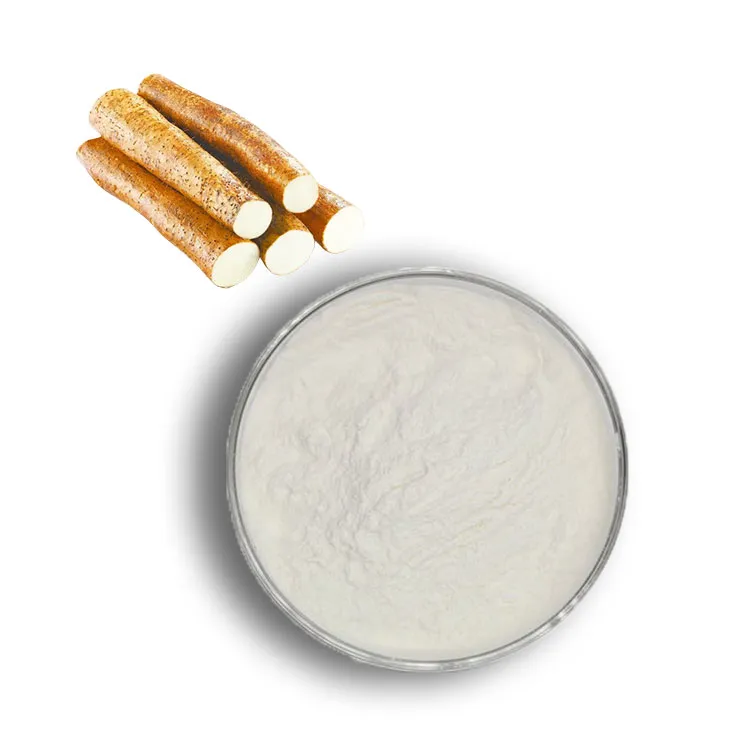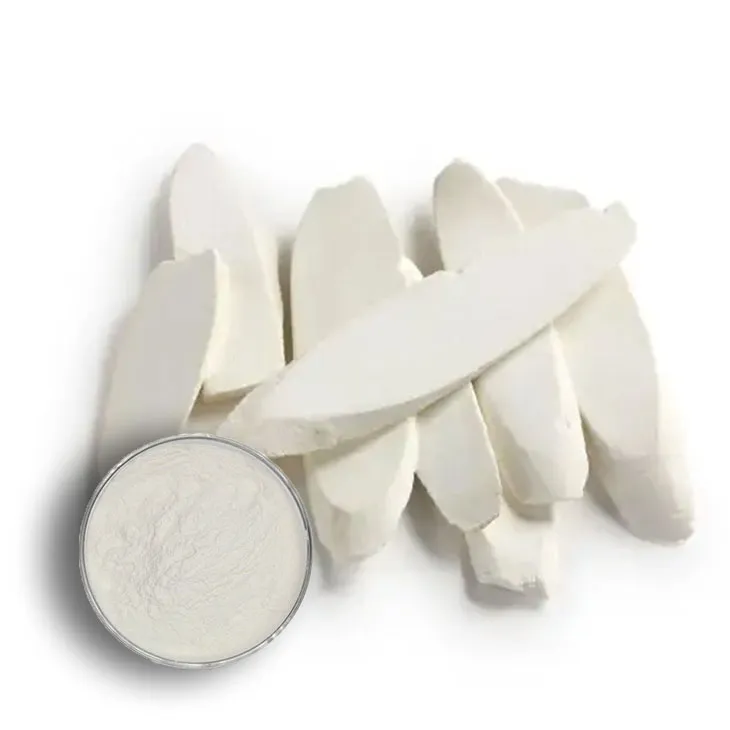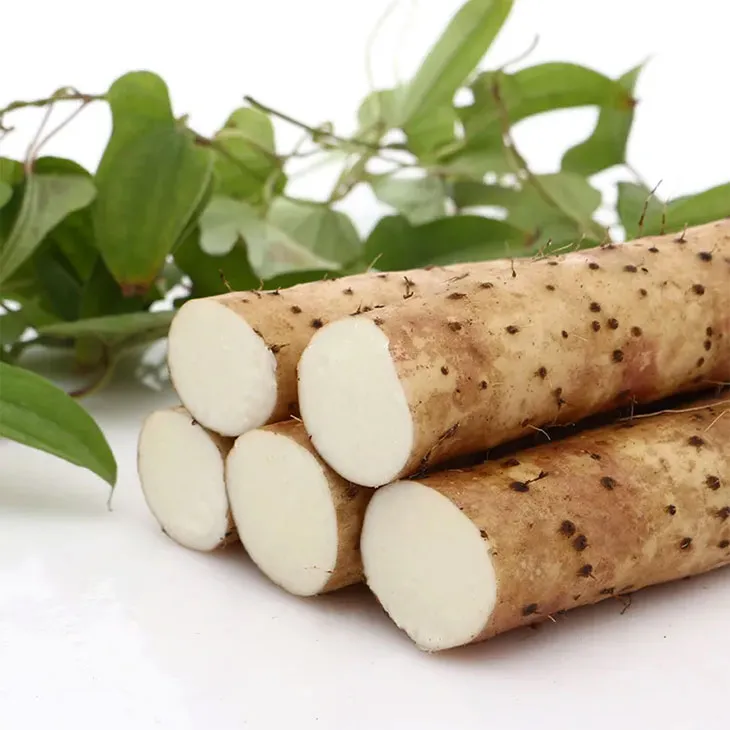- 0086-571-85302990
- sales@greenskybio.com
Extraction process of yam extract.
2024-11-30

1. Introduction
Yam is a widely used plant with rich nutritional and medicinal value. The extraction of Yam Extract has become an important process in the fields of nutraceuticals, functional foods, and herbal medicine. This article will comprehensively introduce the extraction process of Yam Extract.

2. Raw material selection
Yam species and quality: Different yam species may have different compositions and properties. When sourcing yams, it is necessary to select high - quality yams. High - quality yams are usually characterized by intact appearance, no obvious diseases and pests, and firm texture. For example, Dioscorea opposita is a commonly used yam species with relatively high content of active ingredients.
Origin influence: The origin of yams also affects their quality. Yams grown in different regions may be affected by soil, climate and other factors. For instance, yams grown in some areas with fertile soil and suitable climate may have better growth conditions and higher content of beneficial components.

3. Pretreatment of yams
Cleaning: The first step in pretreatment is cleaning. Yams are often covered with soil, impurities and microorganisms on the surface. Thorough cleaning is required to remove these contaminants. This can be achieved by washing with clean water multiple times, and sometimes a mild detergent can be used for more effective cleaning. However, it is necessary to ensure that the detergent is completely removed to avoid affecting the quality of the extract.
Size reduction: After cleaning, the yams need to be prepared for extraction in terms of size. This may involve slicing or dicing them uniformly. Uniform size reduction has several advantages. Firstly, it can increase the contact area between the yam and the extraction medium, which is beneficial for the extraction of target components. Secondly, it can ensure the uniformity of the extraction process, making the extraction results more stable.

4. Extraction methods
4.1 Supercritical fluid extraction
Principle: In supercritical fluid extraction, a supercritical fluid (e.g., carbon dioxide) is used as the extraction medium. Supercritical carbon dioxide has properties between gas and liquid. It has good diffusivity like a gas and can penetrate into the yam tissue easily, and at the same time, it has a certain solubility like a liquid. When the pressure and temperature are adjusted to the supercritical state, carbon dioxide can selectively dissolve the target components in yams.
Advantages:
- Good selectivity: It can extract target components effectively while leaving most of the unwanted substances in the yam residue. For example, it can specifically extract bioactive compounds such as polysaccharides and steroidal saponins from yams, while minimizing the extraction of impurities.
- Environment - friendly: Supercritical carbon dioxide is a non - toxic, non - flammable and chemically inert substance. After the extraction process, it can be easily removed from the extract by simply reducing the pressure, leaving no harmful residues. This is very important for the production of high - quality Yam Extract for use in nutraceuticals and functional foods.
- High extraction efficiency: Due to its good diffusivity and solubility, supercritical fluid extraction can achieve relatively high extraction efficiency in a relatively short time, which can save time and energy costs in the production process.
Process parameters:
- Pressure: The pressure has a significant impact on the extraction process. Generally, the pressure range for supercritical carbon dioxide extraction of yam extract is about 10 - 30 MPa. Higher pressure can increase the solubility of the target components in carbon dioxide, but too high pressure may also bring some problems such as equipment requirements and cost increase.
- Temperature: The temperature also affects the extraction. Usually, the temperature range is 35 - 60°C. Appropriate increase in temperature can improve the diffusivity of carbon dioxide, but excessive temperature may cause the degradation of some thermally sensitive components in yams.
- Flow rate of supercritical fluid: The flow rate of supercritical carbon dioxide affects the mass transfer rate between the fluid and the yam. A proper flow rate can ensure sufficient contact between the fluid and the yam, and promote the extraction of target components. Usually, the flow rate is adjusted according to the scale of the extraction equipment and the nature of the yam.
4.2 Solvent extraction
Principle: Solvent extraction uses organic solvents such as ethanol, methanol or a mixture of solvents to dissolve the target components in yams. The solubility of different components in yams in different solvents varies. For example, polysaccharides may be more soluble in water - containing solvents, while some lipophilic components may be more soluble in organic solvents.
Advantages:
- Wide range of applicable solvents: Different solvents can be selected according to the nature of the target components, which provides more flexibility for the extraction process. For example, if the target is to extract polar components, polar solvents such as ethanol - water mixtures can be used; if non - polar components are to be extracted, non - polar solvents can be considered.
- Relatively simple equipment: Solvent extraction usually does not require very complex and expensive equipment. Conventional extraction equipment such as Soxhlet extractors can be used, which is suitable for small - scale production or laboratory research.
Disadvantages:
- Solvent residues: One of the main problems of solvent extraction is the potential solvent residues in the extract. Even after evaporation of the solvent, a small amount of solvent may remain, which may be harmful to human health if the extract is used in nutraceuticals or functional foods. Therefore, strict control of solvent residues is required in the production process.
- Environmental pollution: The use of organic solvents may cause environmental pollution. Some organic solvents are volatile and toxic, and if not properly disposed of, they may have a negative impact on the environment.

5. Separation and purification of the extract
After the extraction process, the extract obtained usually contains not only the target components but also some impurities. Therefore, separation and purification are necessary steps.
5.1 Filtration
Filtration is a simple and commonly used separation method. It can remove large - particle impurities such as yam residues and undissolved substances in the extract. There are various types of filters, such as filter papers, filter membranes, and sintered filters. The choice of filter depends on the nature of the extract and the required filtration accuracy. For example, if the extract contains fine particles, a filter membrane with a small pore size may be required.
5.2 Centrifugation
Centrifugation can be used to separate substances with different densities in the extract. By rotating the sample at a high speed, heavier substances are sedimented at the bottom, and lighter substances remain in the supernatant. This method is particularly useful for separating emulsions or suspensions in the extract. The centrifugation speed and time need to be adjusted according to the nature of the extract. For example, for an extract with a high viscosity, a longer centrifugation time may be required.
5.3 Chromatographic separation
Chromatographic separation is a more advanced separation method based on the different affinities of components in the extract to the stationary phase and the mobile phase. For example, in high - performance liquid chromatography (HPLC), the extract is passed through a column filled with a stationary phase material. Different components in the extract will have different retention times in the column due to their different affinities, and thus can be separated. Chromatographic separation can achieve high - purity separation of target components, but it requires relatively expensive equipment and professional operation.
6. Drying of the extract
Drying is the final step in the extraction process of yam extract. It is necessary to obtain a stable and storable yam extract.
6.1 Spray drying
Spray drying is a commonly used drying method in the production of yam extract. The principle is to atomize the liquid extract into small droplets and then dry them in a hot air flow. This method has the following advantages:
- Fast drying speed: The small droplets have a large surface - to - volume ratio, which can be dried quickly in the hot air flow, reducing the drying time.
- Good product quality: Spray - dried yam extract usually has good powder properties, such as good fluidity and solubility, which is beneficial for subsequent processing and application.
6.2 Vacuum drying
Vacuum drying is carried out under reduced pressure. The main advantage is that it can reduce the drying temperature, which is very suitable for drying heat - sensitive yam extracts. At low pressure, the boiling point of water is reduced, so the extract can be dried at a relatively low temperature, which can avoid the degradation of heat - sensitive components in the extract.
6.3 Freeze - drying
Freeze - drying is also known as lyophilization. First, the extract is frozen, and then the ice is sublimated directly from the solid state to the gaseous state under vacuum conditions. This method can best preserve the biological activity and chemical structure of the components in the yam extract. However, freeze - drying equipment is relatively expensive, and the drying process is time - consuming, so it is mainly used for high - value - added yam extracts.
7. Conclusion
The extraction process of yam extract involves multiple steps from raw material selection, pretreatment, extraction methods, separation and purification to drying. Each step is crucial for obtaining high - quality yam extract. Different extraction methods and processing parameters have different effects on the quality and yield of the extract. With the development of technology, more advanced and environmentally friendly extraction and processing techniques are expected to be applied in the production of yam extract, further expanding its application in the fields of nutraceuticals, functional foods, and herbal medicine.
FAQ:
What are the main steps in the extraction process of yam extract?
The main steps include carefully sourcing yams, preparing them (such as slicing or dicing uniformly), using an extraction method like supercritical fluid extraction, and then subjecting the extract to separation and drying processes.
Why is supercritical fluid extraction used in yam extract extraction?
Supercritical fluid extraction, such as using carbon dioxide as the extraction medium, has good selectivity. It can extract target components effectively and does not leave harmful residues.
What are the benefits of drying the yam extract?
Drying the yam extract is necessary to obtain a stable and storable product. It helps in maintaining the quality of the extract for further use in various fields.
What makes the resulting yam extract valuable?
The resulting yam extract is rich in nutrients and bioactive compounds. These properties make it valuable in the fields of nutraceuticals, functional foods, and herbal medicine.
Are there other extraction methods besides supercritical fluid extraction for yam extract?
Yes, there may be other extraction methods. However, supercritical fluid extraction is mentioned for its advantages in terms of selectivity and leaving no harmful residues. But traditional extraction methods like solvent extraction may also be possible, though they may have some drawbacks compared to supercritical fluid extraction.
Related literature
- “Extraction Techniques for Bioactive Compounds from Yams”
- “Supercritical Fluid Extraction of Nutrients from Yams: A Review”
- “Yam Extract: Composition, Extraction, and Applications”
- ▶ Hesperidin
- ▶ citrus bioflavonoids
- ▶ plant extract
- ▶ lycopene
- ▶ Diosmin
- ▶ Grape seed extract
- ▶ Sea buckthorn Juice Powder
- ▶ Beetroot powder
- ▶ Hops Extract
- ▶ Artichoke Extract
- ▶ Reishi mushroom extract
- ▶ Astaxanthin
- ▶ Green Tea Extract
- ▶ Curcumin Extract
- ▶ Horse Chestnut Extract
- ▶ Other Problems
- ▶ Boswellia Serrata Extract
- ▶ Resveratrol Extract
- ▶ Marigold Extract
- ▶ Grape Leaf Extract
- ▶ blog3
- ▶ blog4
-
The best - quality feverfew extract.
2024-11-30
-
The best organic aged garlic extract.
2024-11-30
-
Konjac flour manufacturers from China.
2024-11-30
-
Certified organic comfrey extract.
2024-11-30
-
The best sophora japonica extract in 2024.
2024-11-30
-
Black Rice Extract Manufacturers from China.
2024-11-30
-
Nature's Bounty Rhodiola Root Extract.
2024-11-30
-
Peppermint oil manufacturers from China.
2024-11-30
-
Clove Powder
2024-11-30
-
Green Tea Extract
2024-11-30
-
Yam Extract
2024-11-30
-
Lavender Extract
2024-11-30
-
Saw Palmetto Extract
2024-11-30
-
Moringa powder
2024-11-30
-
Artichoke Leaf Extract
2024-11-30
-
melatonin extract
2024-11-30
-
Curcumin Extract
2024-11-30
-
Plantain extract
2024-11-30




















